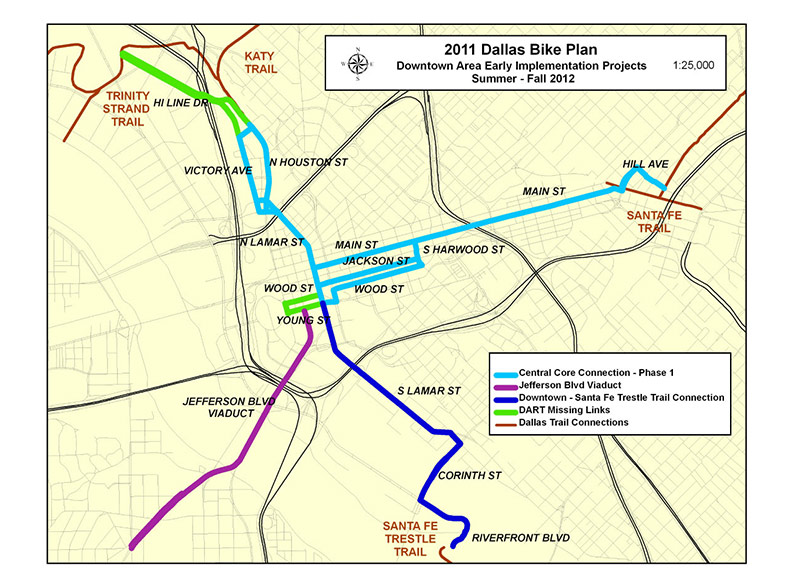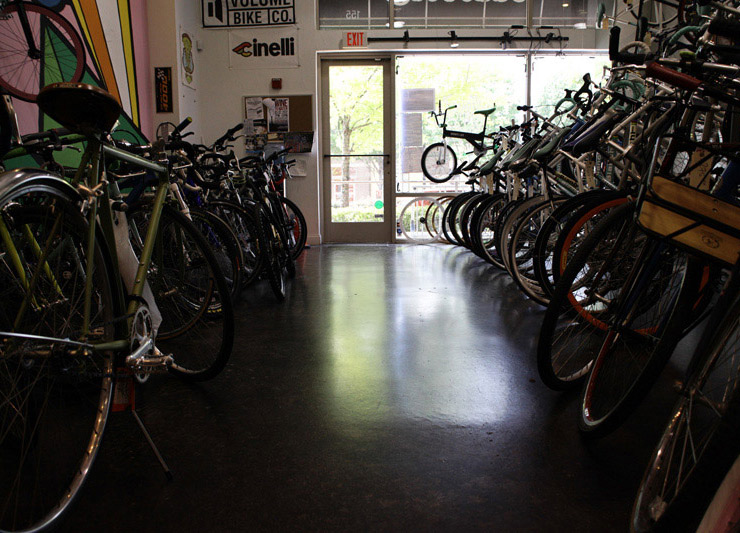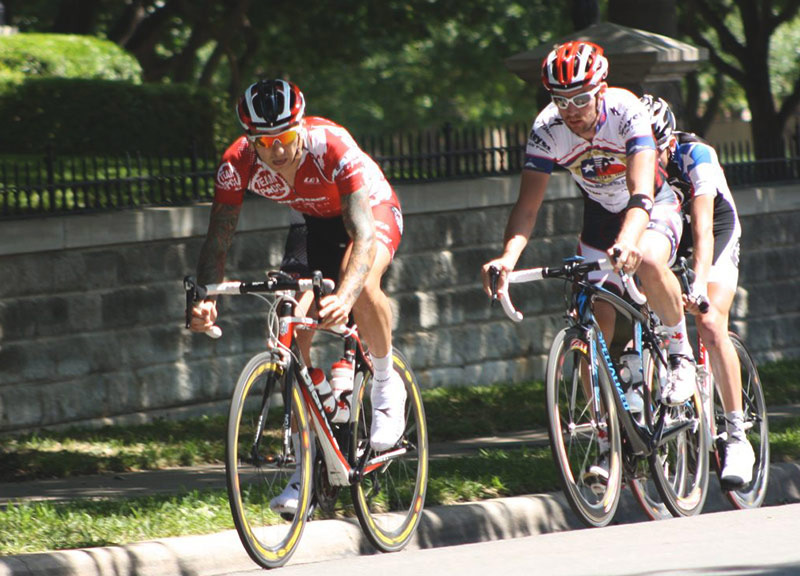A Look At The Current State Of Bicycling In Dallas.
This time last year, Bicycling magazine named Dallas the “Worst City for Cycling” for the second time in just five years.
But, though the city still has a long, uphill climb ahead of it before it cracks the publication’s “Best Cities for Cycling” list, the masses are pretty much in agreement about at least this much: Over the course of the past 12 months, Dallas has greatly improved its bike friendliness.
By how much, though? Having just closed the books on yet another National Cycling Month, now seems like an appropriate time to evaluate the changes that have been implemented in the past year as the city inches towards completing its 10-year bikeway improvement plan — an initiative that that was first launched back in 2011.

According to a briefing given to the City Council back in April, only 136.4 miles of the 1,127 miles laid out by the 2011 bike plan have been completed thus far. The breakdown of those miles looks something like this: 6.5 miles of shared lanes, 1.1 miles of non-buffered bike lanes, 2 miles of buffered bike lanes, a 1.4-mile cycle track on the Jefferson Street Viaduct for cyclists traveling between Oak Cliff and Downtown, and an additional 125.4 miles of trails. Further improvements to the city’s bike-friendliness quotient include the completion of the Centralink (a bike trail connector that goes through Downtown and connects Oak Cliff to the Katy and Sante Fe Trails), the addition of signage all over town reminding motorists to share the road with cyclists and areas of road painted green in order to notify drivers and cyclists of potential conflict areas. Independent of the city, some privately-funded Fixit stations have also started cropping up around town, too.
Still, while the strides that Dallas has made in the past year may ensure that the city won’t be bringing up the rear when Bicycling releases its next list of the worst cycling cities, the city still faces a long track ahead before finding itself on par with such cities as Minneapolis, Portland and Austin, each of which is perennially ranked near the top of bike-friendly city lists.
While that dream might be a good 10 years away — according to the city’s bike plan, at least — Dallasites should start noticing a few more improvements sooner than later. The formation of a City Hall-appointed Bicycle Advisory Committee and the launch of a bike-sharing system (similar to the one Fort Worth just launched back in April) are among the city’s short-term goals. The latter may even happen as early as this fall, per that aforementioned City Council briefing.
If and when a bike-sharing program is adopted in Dallas, it would make rental bicycles available at docking stations located across town. Members of the program would be able to unlock one of these specially-designed bicycles, ride them to a destination and return them to any docking station located nearby.
A little more than a month ago, Fort Worth installed 28 such docking stations across the city to accommodate its own 300 rental bikes. Already, the program is proving quite successful; as of a week ago, 275 residents had already purchased annual memberships into the program, along with over 1,500 short-term passes. Already, says that Fort Worth program’s executive director, Kristen Camareno, there are plans in place to add as many as six more docking stations throughout Fort Worth by August.
But, while increasing cycling infrastructures represents one way to help ensure the safety of bike riders, making sure that motorists are increasingly aware of cyclists is another necessary approach. And that, specifically, is Camareno’s goal with her program, which, she argues, does just that.
“Having the bike-sharing system in place increases awareness for cycling and cyclists in the community,” she says. “Having 300 additional bicycles on the streets of Central Fort Worth creates a safer atmosphere for all cyclists and also encourages Fort Worth to further improve the bicycle infrastructure we have in place.”
Fort Worth mayor Betsy Price agrees with Camareno’s sentiment, for the most part. But she also takes her own argument a step farther: Not only, she say, does the program increase ridership and safety, but it also turns out better citizens.
“I enjoy cycling,” Price says. “But it’s not just about cycling. It’s about the engagement in the city, getting people involved, getting people outside, and getting them healthy. Whether you cycle, walk, swim, run: Get outside and get engaged. I believe it makes for a stronger, more vibrant community. And biking is one particular way to get people out. They see their neighbors, and they see parts of the city they haven’t seen before.”
Does that sound a tad idealistic? Of course it does. But there’s some truth in there as well.

Statistically, bike-sharing programs have had a huge impact on cities where they’ve been adopted: In Lyon, France, cycling increased 44 percent during the first year in which their bike-sharing program was in place; Paris’ system, meanwhile, was directly attributed to a 5 percent reduction in motor vehicle traffic in its first year; and 43 percent percent of people who used Denver’s shared bicycles said they replaced at least one car ride with a bicycle.
In Dallas’ case, the question seems less a matter of whether a bike-sharing program would have an immediate, drastic impact if it were to be implemented, but more of a question about where the City will find the resources to do so.
“A bike-share program can most certainly happen in Dallas, and city staff are researching ways to implement such a program,” says Jared White, who works in the city’s Transportation Planning Division. “The primary obstacle is funding, and Fort Worth was fortunate to receive a grant to help fund their program. City staff are looking at different funding options, where the stations could be located, how the program operates, who maintains the bicycles, and logistics such as moving the bicycles so the stations have an adequate number of bicycles available. There is quite a bit of planning required to implement such a program.”
While Fort Worth did fund their bike-sharing through a national grant awarded to their transportation authority, Dallas resident and biking advocate Jonathan Braddick says he doesn’t see funding as the only issue preventing Dallas from launching such a program.
“I believe that Dallas is even better-suited for such a program, given that we’ve got a light rail and streetcars to further stretch the program all over the DART service area,” he says. “However, it’s not going to happen in Dallas unless the council amends the ordinance to remove the helmet requirement for adults 18 years of age or older.”
Braddick also argues that, at least at the moment, launching a bike-sharing program shouldn’t even really be Dallas’ top concern.
“[Cycling advocates] are getting very impatient with regard to the city re-establishing the Bicycle Advisory Committee formed during the creation of the Dallas Bike Plan,” Braddick says. “Many of us feel this is our No. 1 priority at this time.”

Not even the most optimistic cycling advocate would argue that a bike-sharing program would singlehandedly solve all of Dallas’ cycling problems. But Mayor Price maintains that it is still a critical tool in helping get residents engaged in their community. Not only does biking promote interaction with one’s neighbors, she says, but it can be a helpful tool for politicians to connect with their constituents as well.
“On Wednesday afternoons — twice a month now — we do rolling town hall [meetings] and invite people to come ride with us,” the Fort Worth mayor says. “We’ve gotten a good many things addressed for people just by getting out and talking to them. It’s just a nice way to get out and talk to people and to have people get out and talk to their neighbors.”
Can the same goals be accomplished regardless of whether people own their own bikes or if they simply rent them for short-term use through a bike-sharing program? Sure. But, in the dozens of cities worldwide that have already implemented such programs, statistics also show bike-sharing serving as a successful tool in introducing non-cyclists to the world of cycling. And that’s a fairly important thing, considering that cycling is one of those “safety in numbers” activities, after all.
Still, while those numbers are bound to pick up over time — especially if the city is ever successful in bringing a bike-sharing program to town, as is planned — longtime Dallas cyclists realize that there is much change needed overall for the city to improve its standing as one of the worst communities for cycling in the entire country.
“The city staff in charge of implementing the bike plan are dedicated individuals,” cycling advocate Braddick says. “[But] being a bike-friendly city is still quite new to the city of Dallas, its public servants and its citizens. We have a ways to go to see the entire council, government and citizenry make it one of the top priorities of city.”
Photos by Robert Tracy.
